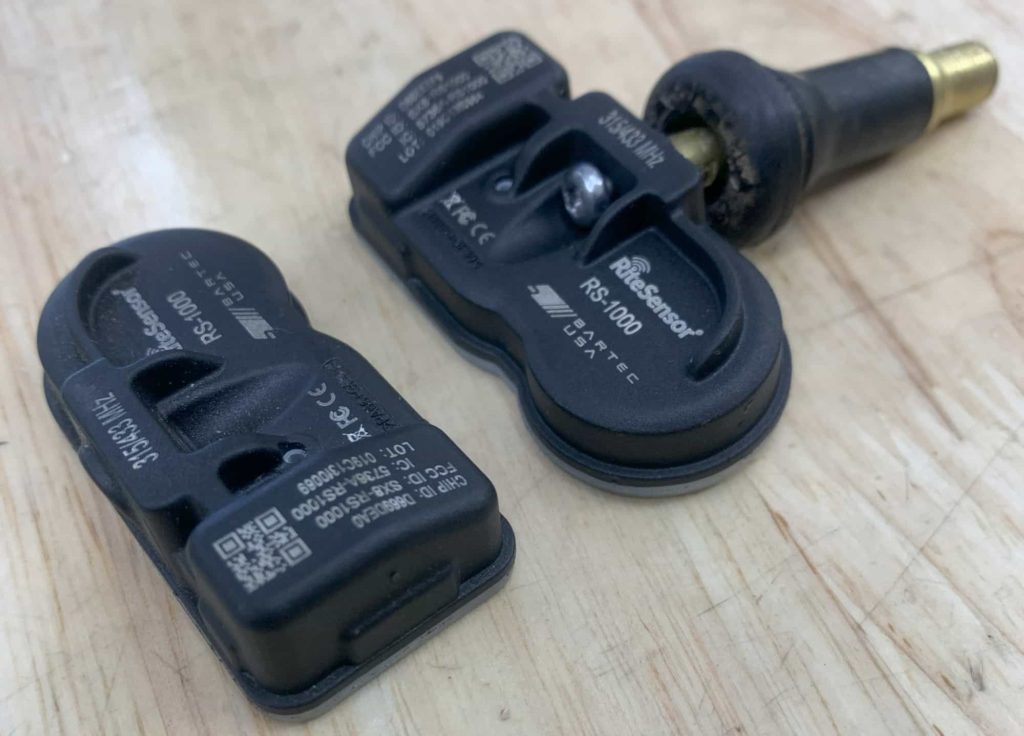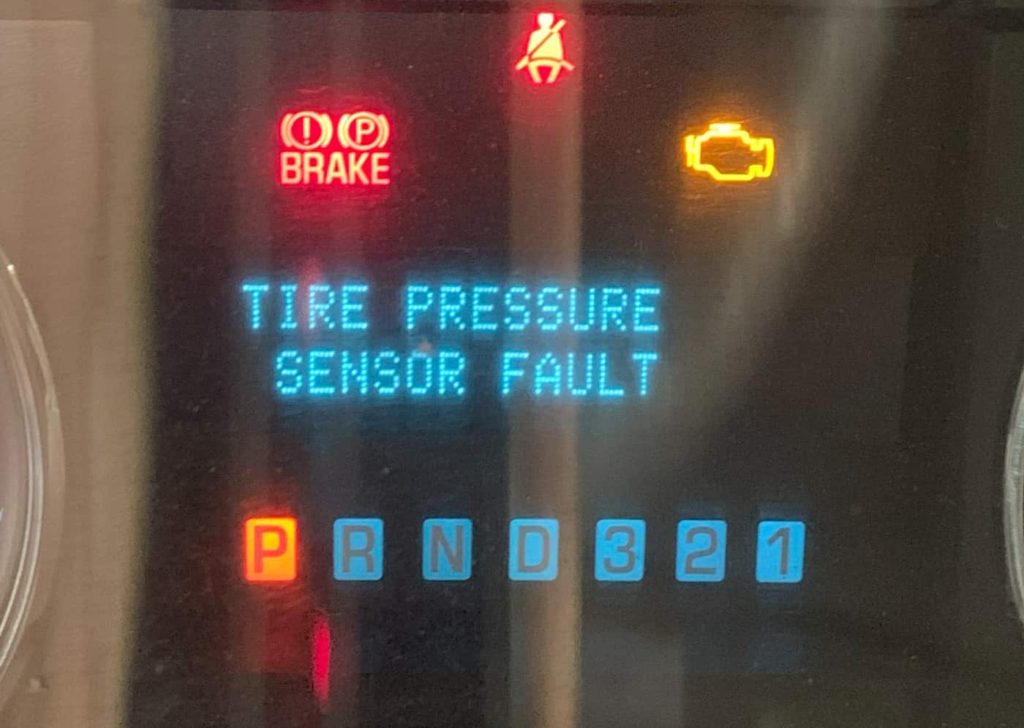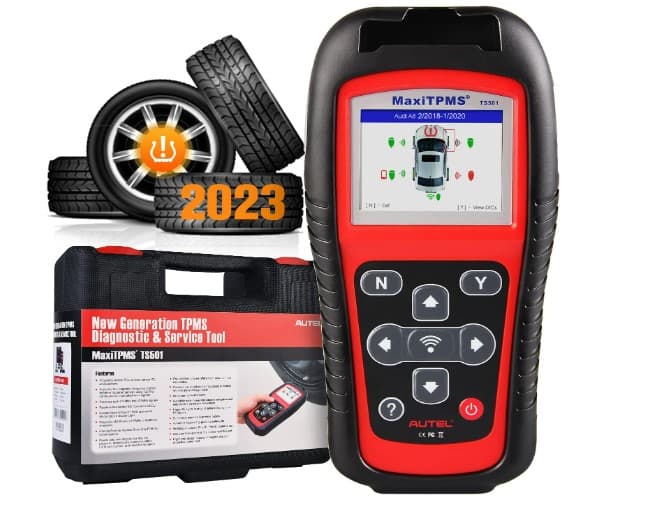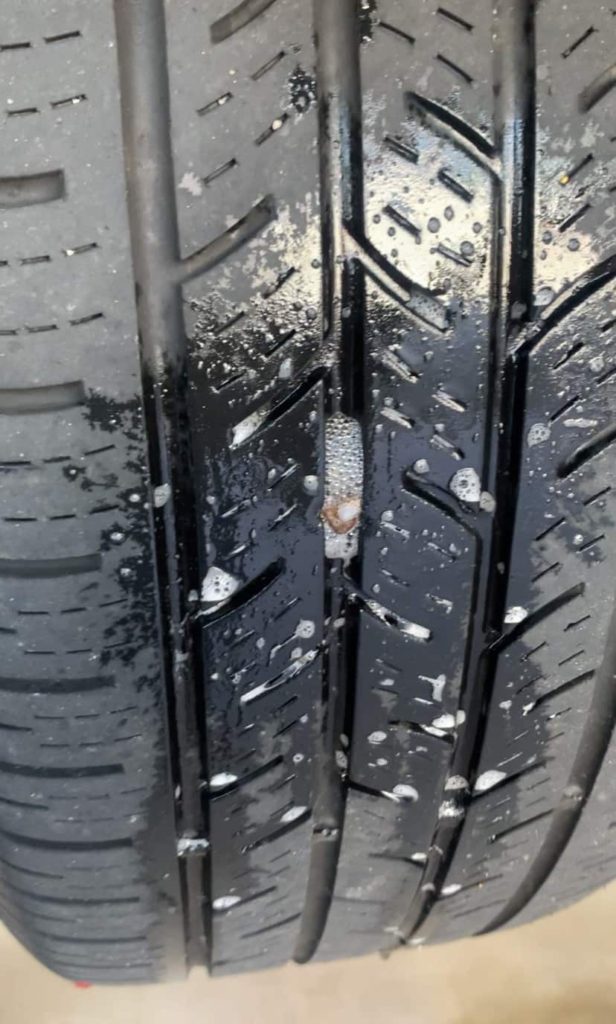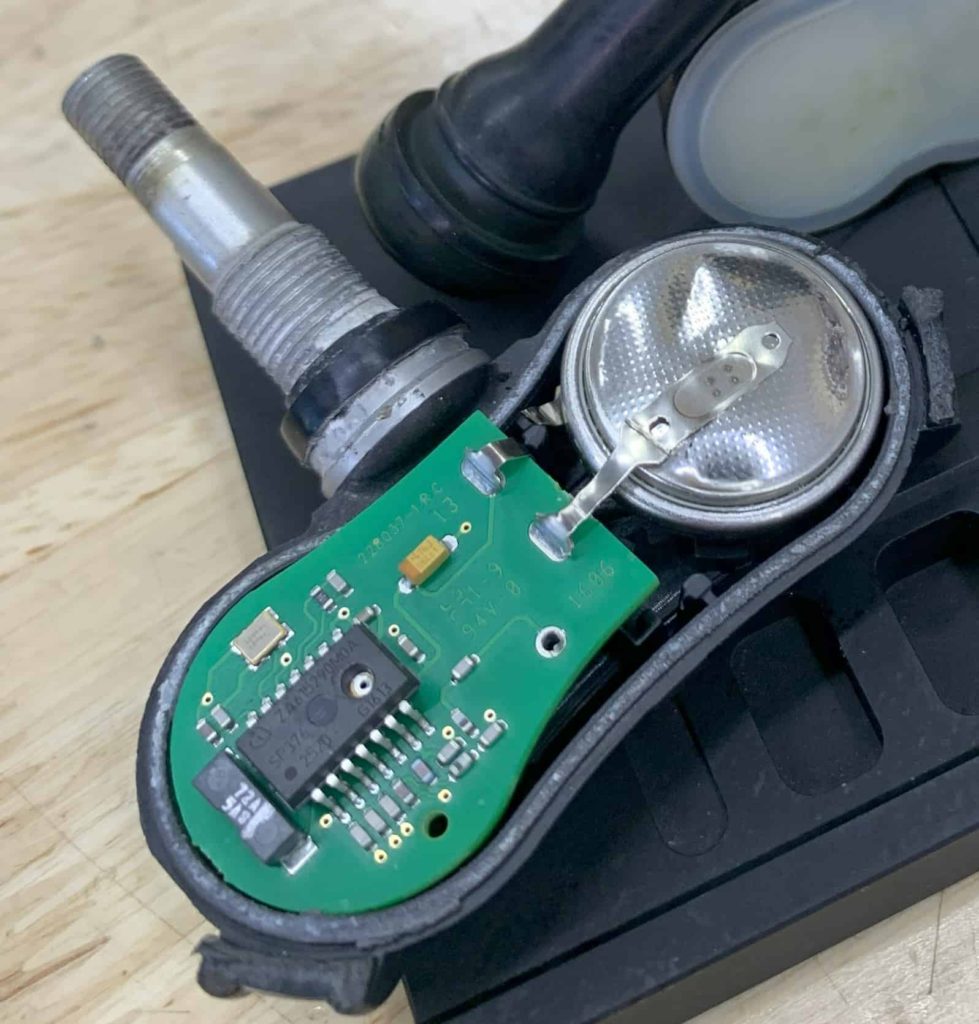Ford Explorer Tire Pressure Monitoring System
The Ford Explorer tire pressure monitoring system is made up of tire pressure sensors, a tire pressure receiver module, an ECU, and a warning system. Ford’s TPMS is designed to monitor and warn drivers if any tires are low on tire pressure.
1. Tire Pressure Sensors
What Are They: Small electronic devices mounted on the inside of each tire. They are housed in a plastic case and attached to the other side of the valve stem.
What do They Do: They measure the air pressure and temperature within each tire. Each sensor has its own unique ID number so that the Explorer ECU can distinguish between each tire’s data.
2. Transmission of Data
How It Works: Once each sensor collects the pressure and temperature data they transmit it wirelessly to the TPMS receiver module.
Frequency: The data is sent wirelessly via radio frequency (RF) signals at regular intervals and when a change in tire pressure is detected. The Ford Explorer sensors use 315 Mhz or 433 Mhz frequency sensors.
3. TPMS Receiver Module
What Is It: This is basically the “mailbox” where all the sensor data and information is sent to.
How it Works: It sorts the incoming data by sensor ID number to make it easier for the ECU to process and interpret the information and know which tire is sending which information.
4. Electronic Control Unit (ECU)
What is it: Think of the ECU as the “brain” of the Ford Explorer. It’s the main computer that processes the data received from the TPMS receiver module.
Decision Making: The ECU compares the current tire pressure data against pre-set pressure thresholds set by Ford. If the pressure in any tire falls below this level, it triggers an alert. The threshold is 15-20% below the recommended pressure.
5. Low Tire Pressure Warning Light
Warning Light: When low tire pressure has been detected, a yellow or orange exclamation mark and a “Low Tire Pressure” message will both occur on the Ford Explorer dashboard. The display screen will also notify the driver of which position tire is causing the problem.
Steps to Reset Ford Explorer Tire Pressure Light
Check and adjust the tire pressure to the recommended pressure when the tires are cold. (Find and use the yellow and white sticker on the driver side door jamb for the correct front and rear tire pressures)
Drive the Ford Explorer for a few miles over 20 Mph (32km/h)
The low tire pressure light will turn off after a few minutes of driving. (Drive for a minimum of 2 minutes)
How to Train the Ford Explorer Tire Pressure Sensors
Follow this procedure after rotating tires or if your tires are replaced and the wheels are mounted back on the SUV in different positions.
After the wheels have been put back on the Ford Explorer, drive above 20 Mph for at least a few minutes. (2 minutes minimum)
Put the ignition in the Off position. (All power off)
Turn the key to the ON position and keep the engine off. (All electricity On)
Press the hazard lights button on and off 3 times within 10 seconds.
If you successfully put the Explorer in “Reset Mode”, you will hear the horn beep one time.
The tire pressure light will begin flashing and a warning will pop up explaining which tire needs training.
If this does not work, repeat the process again.
Get out of the SUV and remove the valve cap from the front left tire. Push the valve stem core in and start releasing air from the tire.
When you hear the horn beep, stop.
A single horn beep confirms that the sensor ID number has been learned by the TPMS receiver module for that wheel position.
Move onto the front right tire (passenger side front). Release air until the horn beeps.
Move onto the rear right tire. Release air until the horn beeps.
Move onto the rear left tire. Release air until the horn beeps.
After the 4 tire beeps, check and fill all 4 tires’ pressure back to the recommended cold pressure values.
The display inside the truck will now say “training complete”
Select OK
Ford Explorer Tire Training Tips
Perform this procedure at least 3 feet away from other Ford vehicles.
Do not wait more than 2 minutes between resetting each tire pressure sensor.
Always perform this process starting with the front left wheel, front right wheel, rear right wheel, rear left wheel.
If you hear a double horn beep you need to repeat the entire procedure.
Don’t forget to put the valve stem caps back on!
How to Change the Ford Explorer Tire Pressure Units
Select settings on the display and press the menu button
Select Display
Select Tire Pressure
Select one of the Tire Pressure Units (Psi or kPa)
What Can Cause the Ford Explorer Low Tire Pressure Warning Light to Turn On?
Issues with TPMS Sensors: Defective sensors or drained sensor batteries can cause inaccurate pressure data on the Ford Explorer’s display as well as a TPMS malfunction.
Reasons for Tire Pressure Loss: Elements like temperature changes, faulty or leaking valve stems, bead seal leaks, tire punctures, cracked wheels or rims, altitude variations, natural air loss, tire dry-rot, and tire aging can all lead to decreased tire pressure.
Breaking Tire Pressure Sensors During Tire Changes: Negligence during the tire installation process can lead to damage to the TPMS sensor.
Inappropriate Tire Inflation: Both excessive and insufficient tire inflation will trigger the tire pressure warning indicator.
Interference from Radio Frequencies: Electronic devices or other vehicles in proximity that operate on similar radio frequencies (433 Mhz or 315 Mhz) as the Ford TPMS sensors can interfere with the pressure system (Manual verification of tire pressures is advisable if TPMS seems off).
Wiring Problems in TPMS Receiver: Faulty wiring, connectors, or plugs associated with the TPMS receiver module can result in a malfunctioning tire pressure system.
Lack of Sensors in Tires: Using tires without pressure sensors, like spare or seasonal replacement tires, will trigger a TPMS malfunction. If you have an additional set of wheels, either transfer the existing sensors or acquire a second set.
Ford Explorer Tire Pressure
Does the Weather Affect the Ford Explorer Tire Pressure?
Weather conditions can have a notable impact on tire pressure due to the thermal properties of air. During colder months the air inside the tires contracts and causes the pressure to drop. In hot weather the air expands, potentially resulting in over-inflation. Generally, for every 10-12 degree change in air temperature the tire pressure will change in the same direction by 1-2 Psi.
How to Check Current Tire Pressure in the Explorer
To check the current tire pressure in the Ford Explorer, use the UP and DOWN arrows on the steering wheel and scroll down until you see the tire pressure display on the information screen.
How to Check Tire Pressure With a Gauge
Locate Specs: Find the recommended tire pressure for your Ford Explorer on the driver’s side door jamb sticker. The sticker is white and yellow and specifies the front and rear pressure.
Gather Tools: Get a digital tire pressure gauge and a tire air inflator.
Cold Tires: Ensure the tires are “cold,” meaning the SUV has been parked for at least three hours or has been driven less than a mile. (Warm tires lead to inaccurate tire readings)
Check Pressure: Remove the valve caps and push the gauge onto the valve stem.
Compare: Compare the measured pressure to the recommended pressure values.
Adjust: If the pressure is too low, use an air compressor to inflate the tire. If it’s too high, release some air by gently pressing the valve stem core. Be sure to set the tire pressures to the exact right pressures.
Recheck: Use the gauge again to confirm that all 4 tires are at the correct pressures.
Valve Caps: Don’t forget to screw the valve caps back on to keep dirt out of the valve stems.
2022 Ford Explorer Wheel Size and Tire Pressures
TIRE SIZE | FRONT PSI | REAR PSI |
255/55R20 | 33 | 33 |
255/65R18 | 33 | 33 |
275/45R21 | 33 | 33 |
SPARE | 60 | 60 |
What Are the Impacts of Driving the Ford Explorer With Low Tire Pressure?
Driving with underinflated tires in the Ford Explorer not only affects performance but also poses significant safety risks.
Increased Tire Wear: Driving with low tire pressure causes the tires to wear unevenly on the road and accelerates tire tread wear significantly on the outer edges of the tread.
Reduced Fuel Efficiency: Underinflated tires create more friction between tire and road increasing the rolling resistance and making the engine work harder and consume more fuel.
Poor Handling: Low tire pressure compromises the Explorer’s grip on the road, affecting steering precision and responsiveness.
Overheating Risk: Underinflated tires can generate excessive heat, increasing the risk of a blowout. Tires are built to withstand a certain temperature, if that temperature is exceeded the rubber will start to break down.
Braking Issues: Slowing down and stopping the SUV will be harder and less controllable.
Diagnosing Ford Explorer Tire Pressure Light
When the tire pressure warning light illuminates on your Ford Explorer’s dashboard, it’s signaling an issue. If you’re certain that the tire pressures are all within the recommended range, the light is usually activated for one of several specific reasons:
One or more tires is losing or low on air.
One or more tire pressure sensors have a dead battery or low battery power.
The TPMS sensors are no longer communicating with the TPMS receiver module or ECU.
Here is a list of solutions to turning off the Ford Explorer low tire pressure warning light:
Option 1: Is a Tire Losing Air?
The primary cause for the activation of the low tire pressure light is usually some form of air leakage. If you fill up a tire that’s low on air and notice that the warning light turns off temporarily but reappears after driving—whether it’s within minutes, hours, or days—this is a significant sign that the tire or wheel in question has a leak. If a tire’s pressure is dropping it’s undoubtedly leaking air.
Option 2: Manually Reset the Explorer TPMS
To manually clear the low tire pressure warning on your Ford Explorer, you’ll need to erase the Diagnostic Trouble Codes (DTCs) from the vehicle’s onboard computer. This requires disconnecting the primary 12-volt battery which cuts off power to the Engine Control Unit (ECU). Before you start make sure the ignition is off and begin by detaching the negative battery terminal. Also ensure that all electrical systems like lights and the radio are turned off. Unplugging the battery will erase all temporary DTCs from the ECU, including those causing the tire pressure alert. After reattaching the negative terminal, the Explorer will enter a “relearning” stage. To finalize this, drive at a steady speed of 50 mph for at least 30 minutes. If the low tire pressure warning comes back on during or after this period, it’s likely pointing to a faulty sensor that needs replacing or a tire that’s losing air.
Option 3: Find Which Pressure Sensor is Low on Battery
If you’re sure that your tires aren’t leaking and you want to pinpoint the sensor triggering the low tire pressure warning, you can assess each sensor using a TPMS diagnostic device. The steps for this are generally consistent regardless of the make or model of the diagnostic tool you’re using. Follow the guidelines provided with the tool to sync it with your Ford Explorer. To check each sensor position the diagnostic device close to the valve stem of each tire and choose the “test” or “trigger” function. Once all sensors have been tested the tool will produce a battery health report for each. If any sensor displays a “low” battery condition, fails to refresh its data, or can’t be registered or tested, it’s an indicator that the particular TPMS sensor should be replaced.
Option 4: The Ford Explorer Tire Light Turns On and Off
If you turn on your Ford Explorer and see the tire pressure warning light illuminate only for it to turn off as you drive, this usually indicates that the tire pressure is marginally below the suggested cold inflation level. This is frequently seen with tires that are cold or haven’t been used recently; as the tires warm up the pressure rises and the warning light deactivates automatically. To address this make sure both front and rear tires are inflated to the exact correct tire pressures.
Option 5: Wake Up an Inactive TPMS Sensor
If you’re confident that the tires aren’t losing air, you can try to reinitiate the connection between the tire pressure sensor and the Ford Explorer’s TPMS receiver module/ECU. Start by deflating the problem tire by 10-15 Psi by pressing in the valve stem core. Pause for a moment and then begin inflating the tire. Instead of the recommended 33 Psi, over fill the tire to 38-40 Psi. With the tire or tires now overinflated, drive the Explorer for a few minutes at speeds exceeding 20 Mph. Subsequently, reset the tire pressures back to the recommended values and drive the SUV once more for a few minutes at speeds above 20 Mph. NOTE: Release air, overfill the tires, drive the SUV, Park it and release air back to regular pressure, drive the SUV.
Option 6: Find Out Where the Air Leak is Coming From
To find where a tire is leaking from, you’re going to need 4 things: a spray bottle, soap, water, and an automotive tire inflator. First, determine which tire is low or losing air and pump it up to at least 33 Psi. Next, create a soapy mixture in your spray bottle by combining the soap and water (solutions like Windex work also). Generously spray this mixture over the entire tire. Don’t forget to soak the bead seal of the wheel and the valve stem. Let the solution sit briefly before meticulously examining the tire for the appearance of small bubbles. If any air is leaking, you will see bubbles.
Ford Explorer Tire Pressure Sensor Batteries
Each wheel of the Ford Explorer comes with an individual TPMS sensor, powered by its own distinct battery. These batteries are made of silver-oxide and resemble those used in wristwatches, calculators, and key fobs. The sensor’s electronic circuit board is directly connected to the battery and the entire thing is encased in a plastic case. Usually the batteries last anywhere from 5-10 years or about 100,000 miles. When a sensor’s battery runs out the entire sensor needs to be replaced. Various environmental factors can influence the battery’s longevity. If you think your Ford has a dead TPMS sensor battery, use solution number 3 above to test it.
Common Ford TPMS Questions
Why is the Ford Explorer Tire Light Flashing?
A TPMS malfunction arises when one or more tire pressure sensors fail to communicate with the Ford’s TPMS receiver module or the ECU. In such scenarios, the tire pressure warning light will flash for approximately one minute and then stay lit. This will happen each time you start the SUV. This usually signals that a tire pressure sensor is due for replacement. This is also the reason the tire light acts up when you’re using the spare tire; the TPMS receiver module recognizes that one of the wheels currently lacks a pressure sensor. It’s crucial to understand that a TPMS malfunction is not indicative of low tire pressure but rather points to an issue with the tire pressure monitoring system itself.
Is it Safe to Drive the Ford Explorer With the Tire Light On?
When or if the low tire pressure warning light comes on in your Ford Explorer, it’s crucial to halt your journey and examine the tire pressures. We suggest manually checking them with a gauge. Determining the reason behind the activation of the tire light is essential for evaluating whether it’s safe to continue driving or not. Ignoring the tire warning light without understanding its cause is ill-advised.
Are Tire Plugs Safe and Reliable?
I have been using tire plugs for many years and believe they are a great solution to fixing a punctured tire. When a tire plug is used correctly it will last the entire life of the tire. Note: Never use a tire plug on a tire’s sidewall.
Should You Use Tire Sealant?
Tire sealants should only be used in last resort or emergency situations. Using tire sealants can cause the tire to be imbalanced as well as damage the electronics of the tire pressure sensor. If you do use a tire sealant, have the tire cleaned out by a professional and have the TPMS sensor tested.
Everything in this article is applicable to all Ford Explorer models and versions including the Ford Explorer Base, XLT, ST-Line, Timberline, Limited, ST, King Ranch, and Platinum.
Please note that this blog post contains Amazon affiliate links. This means that if you make a purchase through one of these links, we at TPMSRESET.COM may earn a small commission at no extra cost to you. We only recommend products that we personally use and believe in. Thank you for supporting us.

